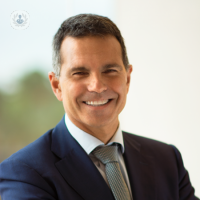The new sutureless valves ( ' sutureless ' ) are the best solution for the elderly patient with aortic valve problems
Written by:The doctor. Xavier Ruyra Baliarda is a specialist in cardiac surgery. Head of Service of the University Hospital Germans Trias i Pujol of Barcelona and Head of the Cardiac Surgery Unit VidaalCor of CM Teknon. His healthcare activity has been focused in particular on heart valve repair surgery, surgery without transfusions, minimally invasive surgery and new alternatives for the treatment of the aortic valve in high-risk patients.
How does the aortic valve work under normal conditions?
The heart is a highly specialized muscle that has a driving pump function to facilitate the circulation of blood to all parts of our body. The heart valves act in a coordinated manner by opening and closing according to the cardiac cycle and ensuring that blood circulates in the correct direction. The normal functioning of the aortic valve is essential so that the heart can empty its contents with each beat without exerting resistance to the flow, and can be closed at the precise moment so that the blood driven does not return to the heart.
What happens if we have a narrow aortic valve (stenosis)?
The obstruction to the flow that conditions that narrow valve determines an overload on the heart, because in each beat it is difficult to push the blood forward. The heart will thicken its walls over the years to be able to beat more strongly and to overcome this obstruction, but there will come a time when it will begin to expand and lose contraction force.. At that time, the patient experiences symptoms such as increased fatigue, difficulty breathing, pain in the chest with exertion or dizziness and loss of consciousness.

Is the affection of the aortic valve very frequent?
It is very frequent and appears mainly in two groups of patients; young patients who have an abnormal aortic valve from birth (bicuspid aortic valve), and elderly patients in whom the valve has degenerated and calcified to narrow significantly. In fact, we could say that if we lived long enough, we would all end up having some degree of involvement in the aortic valve.
What is the treatment of severe aortic valve stenosis?
The treatment is always the replacement of that narrow valve by a new valve that opens and closes properly. Actually, we do not have drugs that work well with this condition and can improve the patient, because basically the problem is a "plug" or difficulty in the ejection of blood that requires removing that obstruction. It is very important to treat all these patients, because apart from the symptoms that prevent a normal life, the vital prognosis will not be good in the short or medium term.
What kind of interventions can be carried out in these cases?
For more than 60 years, surgeons have replaced these diseased aortic valves with different types of valvular prostheses (mechanical or biological) and with very good results.. However, with the progressive aging of the population, we have to operate increasingly older patients with higher surgical risk.. Given this situation, new types of prostheses and new treatment alternatives have appeared that allow us to solve aortic valve problems with better results.
Can that diseased aortic valve be treated by a catheter procedure, avoiding the operation ...?
Currently, we can implant a new cardiac valve through a catheter that we introduce through an artery of the patient's inguinal area. These are the techniques known as TAVI ("Transcatheter Aortic Valve Implantation"). However, these procedures must be reserved for patients who are inoperable and very high risk, since they still present serious problems that are not totally solved.. In the case of TAVI, we do not substitute the diseased valve of the patient, but we introduce a new valve inside the pathological valve itself. As these valves are very thickened and calcified, these procedures can have serious complications (cerebral emboli due to calcium, residual leaks and the need for implantation of a definitive pacemaker) in a significant number of patients.. In addition, vascular problems may appear in the area where the artery enters.
What other alternatives do we have in these patients?
Aortic valve replacement can be done today with modern sutureless valves. These new valves are especially indicated in patients of advanced age or high risk for conventional surgery and allow a much shorter intervention with less aggression for that patient. In this case, the narrow and calcified aortic valve is removed and instead we implant very quickly - and without sutures - a new biological valve mounted on a spring or "stent". The advantages are very significant: it is a large opening valve that offers no resistance to flow, can be placed in a very short time, the possibility of calcium embolism is very low and the presence of residual leaks around the valve is very rare. In addition, these new valves can be placed through very small incisions (only 7 or 8 cm) using minimally invasive surgery techniques. With sutureless valves we have all the advantages of conventional surgery but with much less surgical aggression and fewer complications.
What experience exists today with these new valves?
New sutureless valves are initiating a small revolution in the treatment of severe aortic stenosis. More than 5,000 have been placed in the world with excellent results in the short, medium and long term and could become the valve of choice in a very short time. In CM. Teknon we have been pioneers in the use of these valves in the private sphere and has allowed us to operate very old and high risk patients with very good results.


